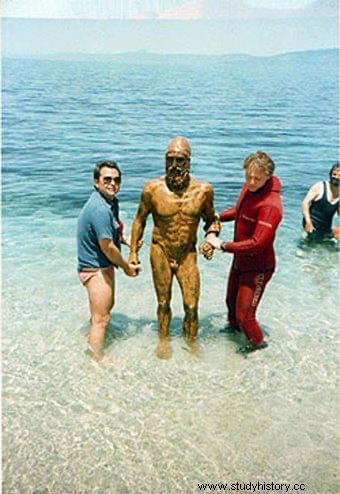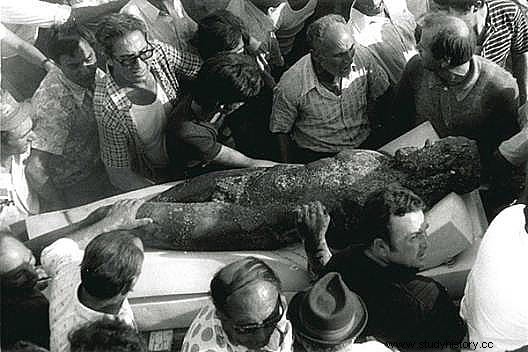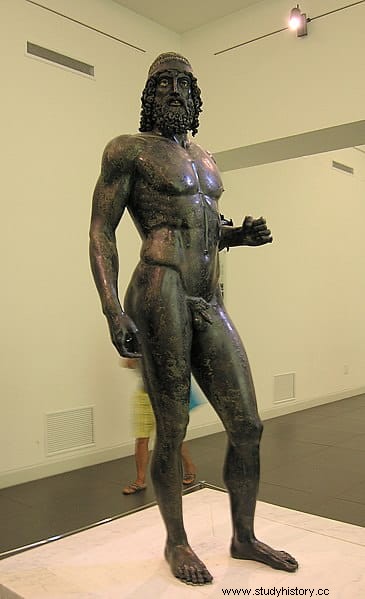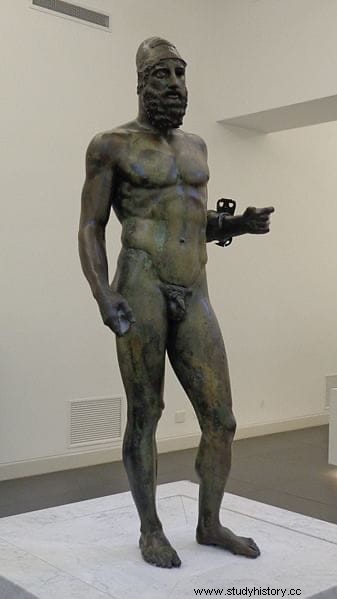On August 16, 1972, one of the most spectacular discoveries in classical Greek art took place. Two nearly intact bronze statues of two male figures, probably athletes or warriors, were found at the bottom of the sea near Riace, in the former Italian province of Reggio Calabria.
The discovery was important because very few bronze sculptures from Ancient Greece have survived to this day. The Poseidon (or Zeus) of the Archaeological Museum of Athens, the Charioteer of Delphi, the Croatian Apoxyomeno, and two statues (an Athena and an Artemis) found in Piraeus, are together with these some of the only examples that remain. The reason they haven't survived longer is that the vast majority were melted down over the centuries to create other things.

That August 16, 1972, a young amateur diver named Stefano Mariottini was struck by something that protruded from the sand of the seabed, about 8 meters deep, in the place where he was practicing underwater fishing 230 meters from the coast. It turned out to be the left arm of one of the statues. Five days after he reported his discovery, by August 21, the Carabinieri had already managed to extract the two pieces from the water.
It was assumed that the statues were thrown into the water from the ship that was transporting them, possibly in Roman times, during a storm. But the search for the wreck was fruitless. Only 28 metal rings and other small bronze objects were found.
The cleaning of the sculptures was carried out by restorers from the National Museum of Magna Graecia in Regio (where they are exhibited today), who confirmed that the bronzes were of Greek invoice belonging to the 5th century BC.
Further analysis revealed that some parts, such as an arm and a forearm, had been melted down and placed to replace the possibly damaged originals. In addition, the teeth of one of the statues, as well as the eyelashes of both, were found to have been made of silver. The lips were copper, and there was ivory and even limestone in other details.
Restoration work concluded in December 1980, with the exhibition of the sculptures to the public for the first time in the Archaeological Museum of Florence. Between 2009 and 2011 a new restoration was carried out in which the soil inside was removed and a chemical product was introduced to preserve them from corrosion. In addition, the statues were placed on anti-seismic Carrara marble bases to isolate them in the event of an earthquake.

The exact date of creation of the sculptures, their author or authors, and who they represent, remains unknown, although researchers have proposed several hypotheses without a consensus being established around any of them.
Some believe that they are the work of different sculptors. The so-called statue A would be the work of Phidias or his workshop around 460 BC, while the statue B it would show typical features of the work of Polykleitos, such as the torsion of the bust or the resting position of the left leg. The study of the materials and the casting technique revealed that there are differences between the two, as if they were made by different artists, or in different periods, or by the same artist in different places.

There is no consensus about who they represent either, and they can be gods, warriors or athletes. One of the most interesting hypotheses is the one that considers them hoplitodromes , participants in the armed hoplite race that took place in the Olympic and Panhellenic Games, among others.
The lead pegs that under the feet of the statues served to fix them to stone bases were made with molds that were found in the sanctuary of Apollo in Delphi, although the bases that supported them could not be found. This could perhaps be an indication that they were part of the offering of some Greek city (with most scholars opting for Athens), and that they could have been originally located on the sides of the Via Sacra of the sanctuary. Others think that they would come from the sanctuary of Olympia, and even from the agora of Athens.

Among the things that stand out is the position of the arms, which may have carried weapons (researchers seem to agree that they carried spears) and shields. Also the head of statue B , which seems smaller than it should be, which can be explained if it was intended to allow the placement of a Corinthian helmet.
A curious hypothesis is that of the archaeologist Sandro Stucchi, who believes that both sculptures represent two different moments of the boxer Eutimo de Locros, the first as a winner when he was alive, and the second as a hero after his death.
And a more recent one identifies statue A with Tydeus of Aetolia and the statue B with the prophet Amphiaraus, both participants in the mythical expedition of the Seven against Thebes (the oracle of Amphiaraus would be co-protagonist of another well-known later story).
Analysis of the soil removed from the feet of the statues revealed that that of statue A came from the plain of the ancient city of Argos in the 5th century BC, while that of statue B came from Athens in the same period.
According to this, the author of the statue of Tideo would be Ageladas, a sculptor from Argos who worked in the sanctuary of Delphi in the middle of the 5th century BC, while the author of the Amphiaraus would be Alcámenes, a sculptor from Lemnos who obtained Athenian citizenship thanks to his artistic ability.
Therefore, the hypothesis that has the most consensus today is that both statues were part of a sculptural group of the seven against Thebes located in the agora of Argos, which was the collective work of sculptors from that city and from Athens. Pausanias in his Description of Greece describes this group, which contained fifteen statues with spears, helmets, swords, and shields.

However, some scholars identify them, within this mythical group, with the brothers Eteocles and Polyneices (the sons of Oedipus who fought for the throne who caused the conflict), and not with Tideus and Amphiaraus.
This option would be supported by the fact that other representations of the brothers are extremely similar in composition to the Riace statues, with a symmetrical pose that would recall their common origin, and even with facial expressions that, in the case of the statue A It would correspond perfectly with the legendary grimace of Polyneices gnashing his teeth when he killed his brother.
Today both statues can be seen in the museum of Reggio Calabria, in a completely aseptic special room that only a few people can enter at the same time, yes, after passing through a germ filter.
